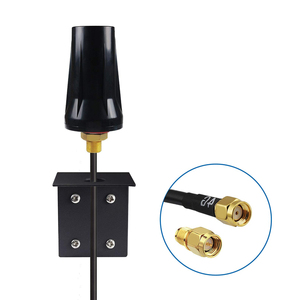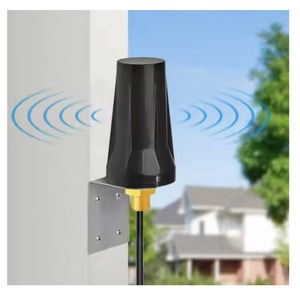
All categories
Featured selections
Trade Assurance
Buyer Central
Help Center
Get the app
Become a supplier

(907 products available)














































Directional Antennas
Directional antennas are one of the most common types of external antennas for the Huawei E5573 mobile broadband router, designed to enhance signal reception, especially in specific directions. Because of their focused signal gain, these antennas can greatly increase data transfer rates and connection stability in regions with weak signals.
Omnidirectional Antennas
Because they transmit and receive signals in all directions, omnidirectional external antennas for the Huawei E5573 are perfect for urban places or settings where the signal sources may be in any direction. These antennas provide a steady signal and can be mounted easily without knowing the exact position of the cell towers.
The tubular form of an omnirectional antenna is frequently a trademark, making it simple to mount on vehicles, buildings, or poles. They frequently work with various frequency ranges, including 4G LTE, 3G, and 2G.
Yagi Antennas
Yagi antennas are a form of directional antenna made to amplify the signal in a fixed direction. They are popular with users who need a stronger connection because of their construction, which consists of parallel elements on a beam. Yagi antennas are excellent for boosting weak signals over long distances because of their exceptional directivity and gain.
Antenna Arrays
For even better performance, two or more antennas can be combined as a spatial array. They are called MIMO (Multiple Input Multiple Output) antenna arrays) because they use various signal paths to improve data speeds and connection reliability. These arrays can transmit and receive multiple signals simultaneously, improving performance in areas with variable signal strength and density.
The durability of external antennas is vital since they are placed in various environments and exposed to adverse weather. Many materials make up the antennas of the Huawei E5573, which impact their longevity, performance, and resistance to the elements.
Weather-resistant casings
The external antennas, which connect to the Huawei E5573, have enclosures that resist water and moisture. High-quality external antennas frequently use enclosures with IP ratings to protect the components from water, dust, and humidity. These features are critical for consistently functioning antennas in locations where rain, snow, or high humidity are common.
UV-resistant materials
UV-resistant materials, such as the outer casings of antenna wires, play a role in the breakdown and fading of plastic and other materials in constant sunlight. Antennas designed for outdoor use often have enclosures constructed from UV-resistant substances, ensuring long-term performance and keeping the external appearance of the antenna intact.
Sturdy mounting brackets and hardware
External antennas have mounting brackets and hardware made from steel or another alloy. These materials ensure the antenna is fixed securely and does not move or become misaligned during windy or severe weather. Corrosion-resistant brackets are especially important for coastal areas influenced by saltwater winds.
Durable housing materials
The antenna's housing is frequently constructed of thick plastic or metal to protect internal components from physical harm. Omnidirectional and Yagi antennas are illustrated with designs that include protective features for their internal parts. This is helpful when talking about installations where the antenna could be accidentally damaged.
High-density urban areas
Because signals can become congested and weak in cities where many people use cell networks, an external antenna can help increase the strength and quality of signals. This is especially critical for enterprises operating in commercial real estate, hospitality, and event venues, where fast, reliable internet access is vital for consumer satisfaction and service delivery. Using the external antenna, the Huawei E5573 could provide reliable high-speed connections for many devices, boosting productivity and decreasing latency.
Remote agricultural operations
Farmers and agribusinesses in rural areas rely on strong mobile data for precision agriculture, remote monitoring, and equipment control. The Huawei E5573 external antennas can help these operations obtain reliable connectivity over large areas, making it easier for producers to control their crops and livestock in real time. Keeping production levels high and downtime low, boosting their bottom line and making value in farming.
Transportation and logistics tracking
Companies in transportation and logistics track fleets, shipments, and delivery times in real time. The Huawei E5573 and a connected external antenna can give these firms a strong, dependable connection while on the go, enabling real-time GPS tracking, communication with dispatch, and updating customer information. This type of connectivity improves efficiency, cuts operating costs, and helps transportation firms deliver better service.
Event and temporary venues
External antennas are ideal for temporary installations like festivals, exhibitions, and sporting events in high-density areas. These external antennas help create reliable multi-user internet access, critical for ticket sales, broadcasting live events, and customer interaction. They lower latency and higher capacity network, on which event organizers depend to ensure customers have dependable internet access.
Signal frequency compatibility
The antenna must be compatible with the frequency bands used by the Huawei E5573 for optimal performance. This model supports LTE/4G, 3G, and 2G in various frequency bands. Omnidirectional or directional, external antennas should be capable of transmitting and receiving the same frequency range for reliable connectivity.
Directional vs. omnidirectional
Omnidirectional antennas are better for urban environments or areas with good signal coverage because they pick up signals from all directions. Yagi or other directional antennas are preferred for rural areas because they help focus the signal in the antenna toward the cell tower, increasing performance at greater distances.
Signal gain
Stronger signal gain generally means better performance. For most external antennas, 5 dBi to 15 dBi signal gains are common. A higher gain can capture faint signals from greater distances and provide a stronger, clearer connection in areas with weaker cell coverage.
Build quality and weather resistance
Because external antennas are placed outside, they need to be weather-resistant and durable, like UV and waterproof materials. Any omnidirectional or directional antenna used outside should be made with materials that can endure harsh conditions like rain, snow, and extreme temperatures to ensure long-term durability and performance.
Mounting and installation
The installation should be simple, and its location should ensure optimal performance. To mount an external antenna, it's usually done on a roof, balcony, or high point to have an unobstructed view of the surrounding area. Consider the type of mounting brackets and hardware to ensure stability and easy installation.
Internal LTE modem and antenna
The external antenna works best when paired with the internal LTE modem antennain the Huawei E5573 mobile broadband router. The E5573 is designed to provide fast, reliable connectivity by combining external antennas with its internal antenna to enhance performance in various environments.
A1:External antennas improve the mobile signal strength and stability of the Huawei E5573. They are especially useful in rural areas or locations away from cell towers since they provide better performance than the internal antenna.
A2:Omnidirectional antennas and directional antennas are common with the Huawei E5573. Antennas help by their application, with omnidirectional antennas for general wide coverage and directional antennas, such as Yagi or panel antennas, focused toward specific cell towers for stronger signals.
A3:Fixing an external antenna is generally simple and straightforward. The antenna and mount are installed at the desired location, the cable is connected to the Huawei E5573, and it's ready to go. Most manufacturers provide clear instructions on how to install the components.
A4:Yes, there are several waterproof and weatherproof external antennas. These are designed to withstand rain, snow, wind, and extreme temperatures, making them ideal for outdoor use.
A5:An external antenna increases the mobile signal; therefore, it can lead to better internet speeds in areas with weak signals. The strength and clarity of the signal directly impacts connection speed and stability.